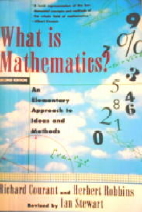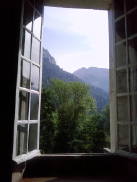Recently, I became intrigued with the discussions of topology that I found among architects and historians of architecture. I saw a few familiar threads running through these discussions – like the emergence and self-organizing principles of biology, together with the view that mathematics was not, primarily, a tool but more a point of view.
I was introduced to the term bioconstructivism in a 2012 paper by John Shannon Hendrix: “Topological Theory in Bioconstructivism.”
Bioconstructivism involves the engagement in architecture of generative models from nature. This is in the tradition of natura naturans in architecture, which is the imitation of the forming principles of nature, as opposed to natura naturata, the direct imitation or mimesis of the forms. According to Plotinus in the Enneads, it is the purpose of all the arts to not just present a “bare reproduction of the thing seen,” the natura naturata, but to “go back to the Ideas from which Nature itself derives”
…An important element of Bioconstructivism is autopoiesis or self-generation, taking advantage of digital modeling and computer programs to imitate the capacity for organisms in nature to organize themselves, or for unorganized or fluid material to consolidate itself, based on the inner active principle of the organism, an “essential force” or “formative drive” which contradicts the mechanistic theories of Galileo, Descartes and Newton. The monad of Leibniz, for example, can self-generate in “integrals” from pre-existing sets of variables, resulting in “continuous multiplicity.”
But I must admit that, from this paper, I didn’t get a clear sense for how topology was used or understood in either architectural design or critique. However, in a 2007 essay on this very topic (on the website RZ-A), I found the following:
Toni Kotnik (the author of ‘The Topology of Type’) believes that the only goal for introducing topology to architecture has been ‘to overcome dialectical strategies of homogeneity or heterogeneity, which dominated the architectural discussion throughout the 20th century’ but rather than giving a real answer to these debates ‘a superficial practice has been established in which every non-linear deformation of the usually used canon of forms gets classified as topological design both by the architect and by the critics.’ (17) He also thinks that the current architecture is not really based on topology but ‘on differentiable dynamical systems and popular spin-offs like chaos theory and fractal geometry’ and suggests that ‘a topological approach to architecture should not be seen as a form-generating tool but as an abstract form of thinking to structure sensorial and rational perceptions in a spatial way’.
I searched for “The Topology of Type,” but found instead, Kotnik’s piece “…there is geometry in architecture.” And here, I was excited to see, a provocative discussion of mathematics and architecture, broader and more interesting than the more specific discussions of various applications of topological ideas.
Kotnik begins with this:
Within contemporary architectural design the form – rule relationship is often understood as the application of geometric rules in a generative process of form-finding, that is rules are a logico-algebraic text out of which architectural form emerges through the manipulation of data. By looking at the etymological roots of mathematics another reading of geometry can be uncovered that relates geometry back to bodily experience and the question of spatial orientation. This enables the re-introduction of the body into contemporary discourse of digital architecture.
Kotnik makes the point that, historically, geometry has been viewed as something that architects use (or consume), not something that they produce. The introduction of digital computing in architecture, however, opens the door to “the emergence of architectural form out of the manipulation of data” which, Kotnik observes, could introduce scientific thinking and methodology into the design process. He moves, then, into the discussion of mathematics that I so much enjoyed, beginning with the etymology of the word mathematics.
…mathematics has its roots in the Greek ta mathemata, which means what can be learned where learning, mathesis, is about the recognition of the unchanged, the stable, of the Being in a world of constant Becoming.
Kotnik argues that mathematics is “the human search for patterns as a means of orientation,” and so “in its original meaning, mathematics is about relating the body with the world around. As such, mathemata is about orientation.” (emphasis added)
Kotnik briefly surveys the developments in mathematics within cultural histories. Euclidean geometry is seen as “an act of physical orientation based on the creation of an intellectual structure,” shaping the individual perception of the world. He calls attention to Riemann’s reformulation of the foundation of geometry, his concept of manifold, and the influence of philosopher Johann Friedrich Herbart is noted. Herbart understood that the variety of perceptions people have, as they move through space, undergo a “graded fusion,” that “glues” individual perceptions together to form a geometric image. Related to the argument I made in Cognition, brains and Riemann, Kotnik suggests
Riemann’s idea of manifolds renders Herbart’s psychological concepts more concrete and precise for mathematical application.
…Euclid’s geometry and its universalized form in Riemann’s manifolds are examples of how mathematical concepts can be created by formalizing the act of orientation.
This discussion of mathematics and architecture rests on the idea that mathematics is not primarily a tool, but almost an articulation of sensation and its consequences. Mathematics, perhaps, can be seen as providing alternative ways to organize sensation or, more to the point, as alternative ways to understand what we see.
I’ll conclude with this last bit from Kotnik:
Measuring space is a central activity for structuring our surroundings and an important orientation element in the human environment. However, this environment must not be understood in a limited way as the purely physical environment. It must be seen more broadly and comprehensively as a multilayered perceptual and experiential space. This expanded understanding of space and the incorporation of the subject into space transforms measurement into an act of individual orientation. The importance of such bodily measuring of space,of geometrein, is not only justified by philosophers like Heidegger, Merleau-Ponty or Deleuze but also by developments in contemporary neuroscience. What emerges is an understanding of architecture as a primarily emotional and perceptual experience grounded in biological values that have to be put forward in the design process.


Recent Comments